
Arkanoid is a 1986 block breaker arcade game developed and published by Taito. In North America, it was published by Romstar. Controlling a paddle-like craft known as the Vaus, the player is tasked with clearing a formation of colorful blocks by deflecting a ball towards it without letting the ball leave the bottom edge of the playfield. Some blocks contain power-ups that have various effects, such as increasing the length of the Vaus, creating several additional balls, or equipping the Vaus with cannons. Other blocks may be indestructible or require multiple hits to break.

Final Lap is a 1987 racing simulation video game developed and published by Namco. Atari Games published the game in the United States in 1988. It was the first game to run on Namco's then-new System 2 hardware and is a direct successor to Namco's Pole Position (1982) and Pole Position II (1983). It was ported to the Famicom by Arc System Works, making it Arc System Works' debut game.

Shinobi (忍) is a side-scrolling hack and slash video game produced by Sega, originally released for arcades on the Sega System 16 board in 1987. The player controls ninja Joe Musashi, to stop the Zeed terrorist organization from kidnapping students of his clan.

Chase H.Q. is a vehicular combat racing game, originally released as an arcade video game by Taito in 1988. It is sometimes seen as a spiritual successor to Taito's earlier Full Throttle. The player assumes the role of a police officer named Tony Gibson, member of the "Chase Special Investigation Department". Along with his partner, Raymond Broady, he must stop fleeing criminals in high-speed pursuits in a black Porsche 928.

Ikari Warriors, known as Ikari in Japan, is a vertically scrolling run and gun video game released for arcades by SNK in 1986. It was published in North America by Tradewest. At the time there were many Commando clones on the market. What distinguished Ikari Warriors were rotary joysticks and a two-player cooperative mode. The rotary joystick controls were in turn based on SNK's earlier TNK III (1985). Ikari was originally intended to be an official licensed adaptation of the film Rambo: First Blood Part II (1985), but SNK were initially unable to acquire the rights to the film.
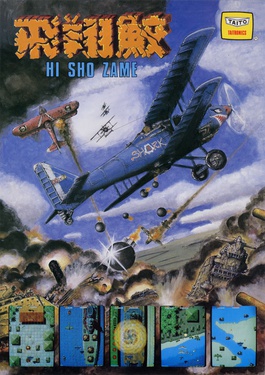
Flying Shark, known as Sky Shark in North America, is a 1987 vertically scrolling shooter arcade video game originally developed by Toaplan and published by Taito in Japan, Romstar in North America and Electrocoin in Europe. Controlling the titular biplane, the players must fight endless waves of military vehicles while avoiding collision with their projectiles and other obstacles. The plane has a powerful bomb at its disposal that can clear the screen of enemies when fired. It was the third shoot 'em up game from Toaplan, and their eighth video game overall.

Operation Wolf is a light gun shooter arcade game developed by Taito and released in 1987. It was ported to many home systems.

Commando, released as Senjō no Ōkami in Japan, is a vertically scrolling run and gun video game released by Capcom for arcades in 1985. The game was designed by Tokuro Fujiwara. It was distributed in North America by Data East, and in Europe by several companies including Capcom, Deith Leisure and Sega, S.A. SONIC. Versions were released for various home computers and video game consoles. It is unrelated to the 1985 film of the same name, which was released six months after the game.
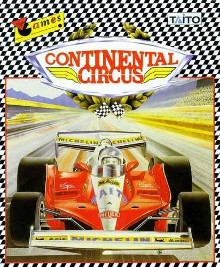
Continental Circus is a racing simulation arcade game, created and manufactured by Taito in 1987. In 1989, ports for the Amiga, Amstrad CPC, Atari ST, Commodore 64, MSX and ZX Spectrum were published by Virgin Games.

Special Criminal Investigation, also known as S.C.I. for short or as Chase HQ II: Special Criminal Investigation in some home versions, is vehicular combat racing game published by Taito for arcades in 1989. It is the sequel to the 1988 game Chase H.Q.
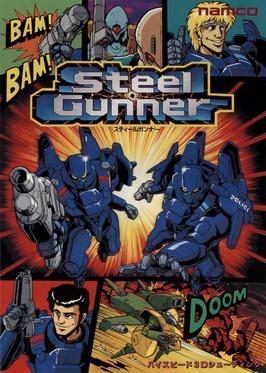
Steel Gunner is a 1990 first-person shooter arcade game developed and published by Namco. Players take control of Garcia and Cliff, a duo of police officers that are part of the Neo Arc police force, as they must use their powerful Gargoyle mecha suits to destroy the STURM terrorist organization, who have taken captive scientists Dr. Ryan and Dr. Ellis to create a world-ending superweapon. Gameplay revolves around using a crosshair to shoot down enemies and avoid harming civilians. It runs on the Namco System 2 Plus arcade hardware.
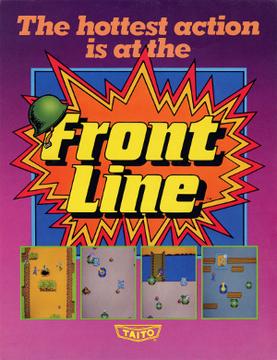
Front Line is a military-themed run and gun video game released by Taito for arcades in November 1982. It was one of the first overhead run and gun games, a precursor to many similarly-themed games of the mid-to-late 1980s. Front Line is controlled with a joystick, a single button, and a rotary dial that can be pushed in like a button. The single button is used to throw grenades and to enter and exit tanks, while the rotary dial aims and fires the player's gun.
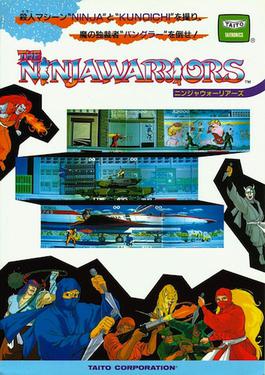
The Ninja Warriors (ニンジャウォーリアーズ) is a side-scrolling beat 'em up video game developed and released by Taito in 1987. The original arcade game situated one display in between projected images of two other displays, creating the appearance of a triple-wide screen. Ports were released for home systems including the Amiga, Atari ST, ZX Spectrum, Commodore 64, Amstrad CPC, PC Engine, and Sega Mega-CD.

Rambo III is a series of video games based on the film Rambo III (1988). Like in the film, their main plots center on former Vietnam-era Green Beret John Rambo being recalled up to duty one last time to rescue his former commander, Colonel Sam Trautman, who was captured during a covert operation mission in Soviet-controlled Afghanistan. Taito released an arcade video game based on the film. The console versions were developed and published by Sega, the IBM PC compatible version was developed by Ocean and published by Taito, and Ocean developed and published the other home computer versions: Atari ST, Amiga, Spectrum, C64, Amstrad CPC.

Sea Wolf is an arcade video game designed by Dave Nutting and released by Midway in 1976. It is a video game update of an electro-mechanical Midway game, Sea Devil, itself based on Sega's 1966 electro-mechanical arcade submarine simulator Periscope. The game was released in Japan by Taito. In Sea Wolf, the player, piloting an unseen submarine, launches torpedoes vertically in an attempt to sink ships moving horizontally across the screen before time runs out. The screen is viewed through a faux periscope mounted on the cabinet.

Space Gun is a 1990 first-person shooter arcade game released by Taito. The game is set aboard a crippled space station that has been overrun by hostile alien creatures. The objective is to rescue human crew members while destroying the alien creatures. The game lets the player shoot limbs off the creatures, resulting in blood splatters.

Full Throttle, also known as Top Speed, is a one-player racing arcade game developed by Taito in 1987. It is very similar in style to the Out Run games in that it features a fast, red car hurtling through the US countryside. The key difference in gameplay is the addition of a nitro boost button. The game was released under the title Full Throttle in Japan, Top Speed in North America, and both Full Throttle and Top Speed in Europe.
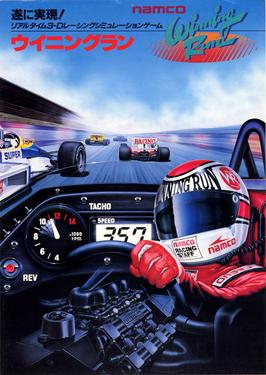
Winning Run is a first-person arcade racing simulation game developed and published by Namco in late December 1988 in Japan, before releasing internationally the following year. The player pilots a Formula One racer, with the objective being to complete each race in first place, all while avoiding opponents and other obstacles, such as flood-hit tunnels, pits and steep chambers. It was the first game to run on the Namco System 21 arcade hardware, capable of 3D shaded polygons.
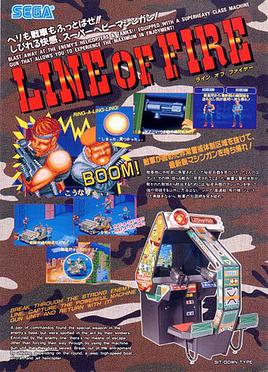
Line of Fire is a first-person light gun shooter game developed by Sega and released for arcades in 1989. It was released with two arcade cabinet versions, a standard upright and a sit-down cockpit, both featuring two positional guns. The cockpit design allows the player(s) to sit down while playing the game, while having two-handed machine guns, controlled by a potentiometer-controlled gun alignment software system. The game follows a two-man commando unit as they try to escape from a terrorist facility after seizing a prototype weapon.

Speed Race is a 1974 arcade racing video game developed and manufactured by Taito and released under the titles Racer and Wheels in North America by distributor Midway Manufacturing in 1975. Designed by Tomohiro Nishikado, the gameplay involves the player using the attached steering wheel to maneuver a car alongside a fast vertical scrolling road. The objective is to score points by driving past other cars without colliding with them; more points are awarded for driving faster. Players must do this under a 90-second time limit, which ends the game when it runs out. The gameplay concepts were adapted from two earlier driving electro-mechanical games: Kasco's Mini Drive (1958) and Taito's Super Road 7 (1970).





















